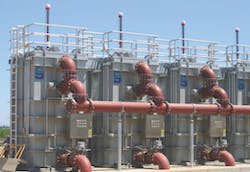Rising to New Heights
As greater restrictions are being placed on industrial and municipal plants, filtration systems are being pushed to greater operating levels. The Schreiber Fuzzy Filter has enjoyed a distinct advantage over conventional media and disc-type filters by virtue of its ability to operate at over five times conventional flux rates while maintaining greater effluent quality than those technologies. The Fuzzy Filter can effectively remove suspended solids down to 4 microns, which exceeds typical media filter performance. If sand filters pursue finer removal by employing ultra-fine media, operating flux rates are often compromised.
The Fuzzy Filter was originally developed as a tertiary treatment step for the Schreiber wastewater treatment system and first installed in 1995. It has expanded far beyond this duty into a multitude of industrial applications, such as cooling water, storm water, river water, membrane backwash water and pre-reverse osmosis filtration. Although Fuzzy Filters are typically designed to operate in a flow range of 25 to 30 gpm per sq ft, the ability to function at flow rates of up to 40 gpm per sq ft give them significant built-in residual capacity. This offers savings in foundation, piping and electrical installation costs. This high flux rate permits Schreiber to install fewer filters than other manufacturers. Therefore, the installed filter package offers significant overall project savings. We have frequently seen that the Fuzzy Filter’s smaller system footprint is able to go where others cannot. This feature is valuable when existing plants try to respond to discharge regulation changes or increased capacity requirements by installing additional equipment into a plant that offers limited floor space.
As testament to The Fuzzy Filter’s ability to perform at flux rates well beyond those of any other current supplier in the marketplace, extensive testing was conducted for the California Department of Public Health Services (CDPH) in 2010 for acceptance of the Fuzzy Filter’s compressible media technology for tertiary treatment of wastewater for reuse applications in accordance with Title 22 regulations. The Fuzzy Filter had been approved by the CDPH in February 2003 for operation at 30 gpm per sq ft. Multiple installations have been added and successfully operated in California since that time. The recent testing and acceptance has expanded operation of Title 22 applications to 40 gpm per sq ft. Final acceptance was received from the CDPH in July 2011.
